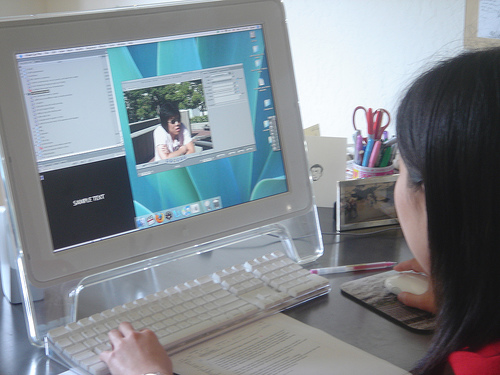The Basics of Fanvids

A fanvid, also sometimes called a vid or songvid, is a fan-made music video that combines music with television or film footage to tell a story or make an argument. Although fanvids are related to video remixes such as Scary Mary, which recuts Mary Poppins as a horror movie, and the two art forms sometimes overlap, they are not the same.
As video-editing software has become increasingly accessible to the general public, the popularity of vidding has exploded, but it still faces some tricky legal questions.
A Brief History of Vidding
A Star Trek fan named Kandy Fong used casette tapes and slideshows to create the first known live action fanvid in the mid-70's. She displayed her vids at conventions up and down the West Coast through the 90's. Recorded footage of "Both Sides Now," one of her most famous slideshow vids, is now available online.
With the advent of VCR technology, fans began to copy footage from one tape to another in order to create vids, a time consuming process that was eventually superseded by the arrival of computer video editing software.
As computers have grown increasingly more powerful, it has become increasingly easy to start vidding. Most computers now even come preloaded with simple video editing programs such as Windows Movie Maker or iMovie, programs that many modern vidders got their start with. With the advent of YouTube and other streaming video sites, fanvids not only became easy to make, but also easy to share with a wide audience. After decades of secrecy, the vidding movement is suddenly hard to avoid.
A fanvid called "Vogue" was discovered by New York Magazine, who promptly named it one of the funniest videos of 2007 and later did an interview with its creator, Luminosity, a popular vidder who has been creating vids since the VCR days.
Vogue
Learn More
- Vidding - Fanlore
Vidding is the act or process of creating a fan-oriented vid or fanvid using live action TV or movie footage set to music. - How to Watch a Fan-Vid
A somewhat academic discussion of the history and culture of fan-vidding, centering on discussion of a well known Kirk/Spock slash vid named "Closer" - vidding intro via imeem
An introduction to understanding fanvids - Fanvidding: a labor of love
- DIY Media: Fan Vids, Part 1
- DIY Media: Fan Vids, Part 2
- Vidder Profiles
Legal Questions and Why We Vid
In the interview, Luminosity touched on the reasons fans vid, and also on its precarious legal situation. Much like fanfiction, fanvids are based around copyrighted materials, and unlike fanfiction, even uses those materials directly.
Although fans believe that vidding falls under the legal definition of "transformative works," copyright holders do not always agree. Many turn a blind eye to vidding, recognizing that it often amounts to free advertising, but others have pursued legal action against vidders. In order to protect themselves, vidders never accept monetary compensation for their vids, and most continue to keep a relatively low profile, even as mainstream culture has become increasingly aware of the phenomenon. As mainstream scrutiny has increased, vidders have also joined with fanfiction writers and other creators of fanworks to start the Organization for Transformative Works, which seeks to protect creators of fanworks.
Why We Vid, Why We Watch
The OTW also seeks to preserve and document fan culture, and as part of that effort, has created an interesting documentary about vidding, intended for high school and science/technology students:
- What Is Vidding?
- Tech and Tools
- Good Vids, Bad Vids
- Collaboration and Community
- I Like to Watch
- Why We Vid
Vidding is often differentiated from simple remixes like the "Scary Mary" trailer linked above by its emotional aspect. For many vidders, vids are primarily a way to make an emotional argument about its source, whether that argument is as simple as "I love my show!" or as complex as another of Luminosity's well-known vids, "Women's Work," a searing critique of the sexualization of violence against women in the television show Supernatural and, by extension, all television.
Getting Started With Fanvids
The subtlety of some of these arguments can present a barrier to mainstream acceptance of fanvids. In a fascinating interview with vidder Franscesca Coppa, Reason Magazine commented "The vids I found most accessible at the DIY conference were videos like A Fannish Taxonomy of Hotness, where you don’t have to be familiar with a particular show to understand them but you have to be familiar with TV and the clichés of the medium."
For many vids, it is very important to know the source material. As Coppa explains: "There’s a really funny Stargate Atlantis vid which just looks like a sappy love story between two of the show’s characters. But the joke, if you know the show, is that the vidder has worked the footage to put these characters into scenes that they weren’t in together. The vid’s called Too Good to Be True, for the love song: “You’re just too good to be true/Can’t take my eyes off of you,” etc. But this footage is literally too good to be true. Half of these scenes never happened!"
If you're interested in watching vids, start with multifandom vids or vids centered on TV shows or films you are familiar with. One of my favorite multifandom vids is the fun and highly accessible (even if you aren't familiar with its fandoms) "I Enjoy Being a Girl." (You can read some interesting discussion about why this particular vid works at NewTeeVee.com.)
I Enjoy Being a Girl
Some vids are even centered on famous people, such as "Piece of Me," a surprisingly clear-eyed look at the life and times of Britney Spears.
Piece of Me
Do prepare for some disappointment. For every star of Luminosity's talent, there are many newbies and even experienced vidders who just haven't gotten it quite right yet. YouTube has already gained notoriety in the vidding community as a bastion of poor quality vids.
To help you weed through the bad stuff and find the good, here are a few tips:
- Look for high video and sound quality. Just as you wouldn't publish a story riddled with spelling and grammar errors (I hope), a good vidder always seeks to post a video with the highest quality video and audio possible. Many serious vidders favor sites such as blip.tv and vimeo over YouTube because it allows higher video and sound quality.Another large community of vidders now posts at the vidding social network Vidders.net.
- Avoid talky-face videos. Videos with lots of long clips of people talking to each other are a mark of inexperienced vidders. Although a certain amount of talky face is usually unavoidable, experienced vidders usually seek to minimize it or incorporate it into the vid in some way, such as the moment at 3:04 in this good (though R-rated) "recruiter vid" for Battlestar Galactica.
- Look for good use of music, especially lyrics and beat. Excessively literal use of lyrics is another common mark of the newbie vidder, though it can also be used quite cleverly. However, there are almost no exceptions to the rule that good vids must match the beat and tempo of the music. Although especially important for vids with large amounts of action, it is important even for more introspective character or relationship studies. The remarkably beautiful Flyboys vid Cathain is an example of a vid that makes stunning use of beat and tempo.
Most of all, have fun!








